Why The Saint Bartholomew Statue In Milan Shows Him Holding His Own Skin
The Fate of Saint Bartholomew
Visitors to Milan’s Duomo are often shocked by the Saint Bartholomew statue. Unlike other statues in the church, Saint Bartholomew stands completely naked, wearing his own skin thrown over his shoulder. That’s because Saint Bartholomew was flayed, literally skinned alive as a punishment for converting people to Christianity. Sculpted by Marco d’Agrate in 1562, the statue of St. Bartholomew shows the apostle completely stripped of his skin, holding a knife in his hand.
Bartholomew was just one of many Christian martyrs who suffered a gruesome demise. St. Lawrence was roasted alive on a grill over hot coals. St. Euphemia was fed to lions and bears. And St. Castulus was buried alive. Why did artists paint and sculpt scenes of torment? Martyrdom was a badge of honor for these Christian saints because their suffering brought them closer to Christ. By showing a skinned saint, artists drove home the story of Bartholomew’s life.
St. Bartholomew’s Statue Is Draped In His Own Skin Because He Was Flayed Alive
As a result of his martyrdom, for centuries St. Bartholomew was shown holding his own skin. The statue of St. Bartholomew in Milan, created by Marco d’Agrate in the 16th century, remains one of the most realistic artistic depictions of the saint.
The Grisly End Was Punishment For Converting A King

Photo: Francisco Camilo / Wikimedia Commons / Public Domain
According to the Golden Legend, written during the 13th century, Bartholomew earned his grisly martyrdom for converting a king in India. As one of Christ’s apostles, Bartholomew traveled the world spreading the message of Christianity.
On his trip, Bartholomew cast out several demons, convincing King Polemius to convert to Christianity. Bartholomew’s religious mission enraged the king’s brother, who ordered the apostle’s end.
The text explained how the angry brother ripped Bartholemew’s clothes off, ordered him beaten and commanded that his underlings flay the apostle alive.
The Saint Was Flayed Like A Leather Bag
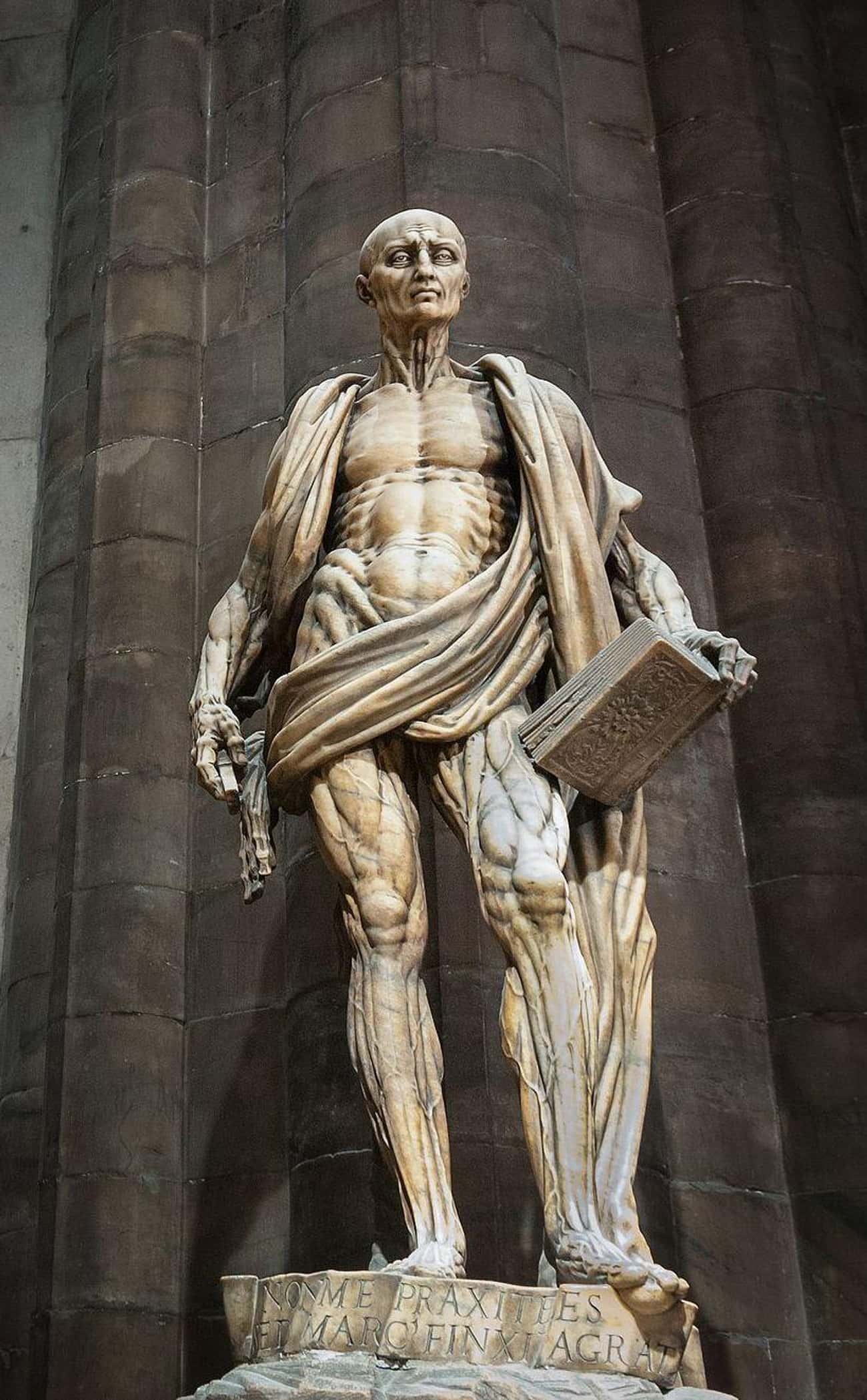
Photo: Latente Flickr / Wikimedia Commons / CC BY-SA 2.0
The story of St. Bartholomew appeared in many texts. One, by St. Theodore Studita who wrote in the 11th century, used an animal metaphor to describe the saint’s death.
“After he had to be in such great and intolerable pain,” Theodore explained, “he had been played by the wicked [one], in the manner of a leather bag.”
The statue in Milan harkens back to Theodore’s description. Bartholomew drapes his own skin over his body as though it were cloth or leather, wearing it like a garment.
Other Sources Disagree On Bartholomew’s Demise
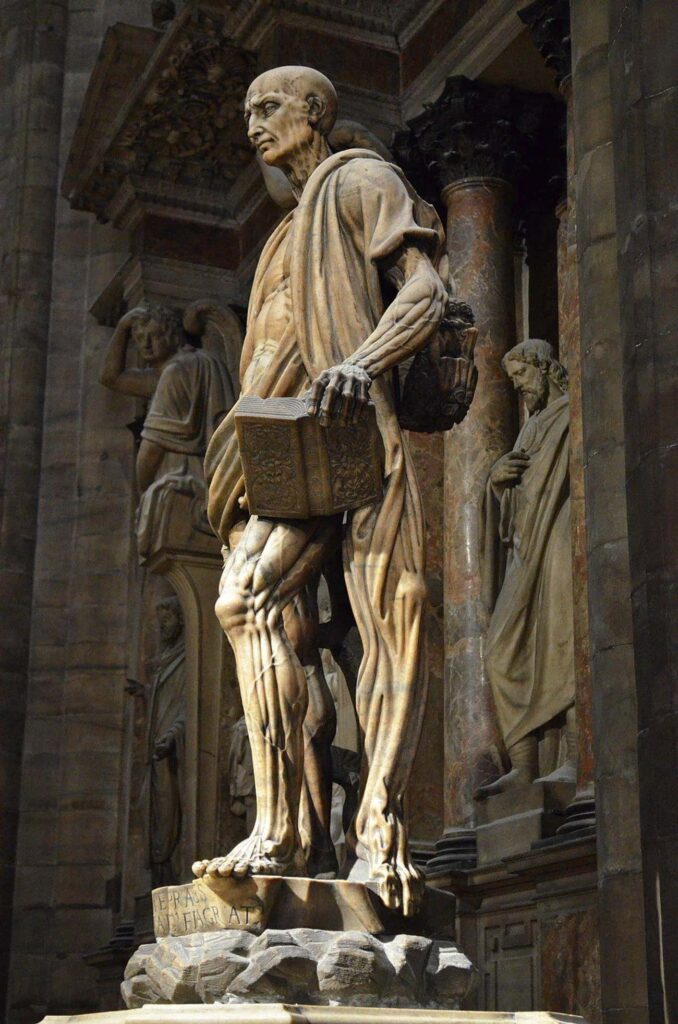
Photo: Darafsh / Wikimedia Commons / CC BY-SA 3.0
The famous statue in Milan shows the apostle holding his own skin. But some sources claim Bartholomew was never flayed.
The 13th century Golden Legend says Bartholomew was flayed alive in India but also records other accounts of the saint’s martyrdom. For example, St. Dorotheus said Bartholomew was not flayed but instead perished from an upside-down crucifixion. Ambrose and St. Theodore recorded that Bartholomew was flayed, but Theodore claims the story happened in Albania, and that the saint had his head removed after being flayed. Other sources only the latter punishment took place say.
The author of the Golden Legend, Jacobus, tried to combine all three claims, stating that Bartholomew was pulled off the crucifix so he could be flayed and then decapitated.
Some Artistic Renderings Only Depict His Flaying, Others Include His Head Coming Off
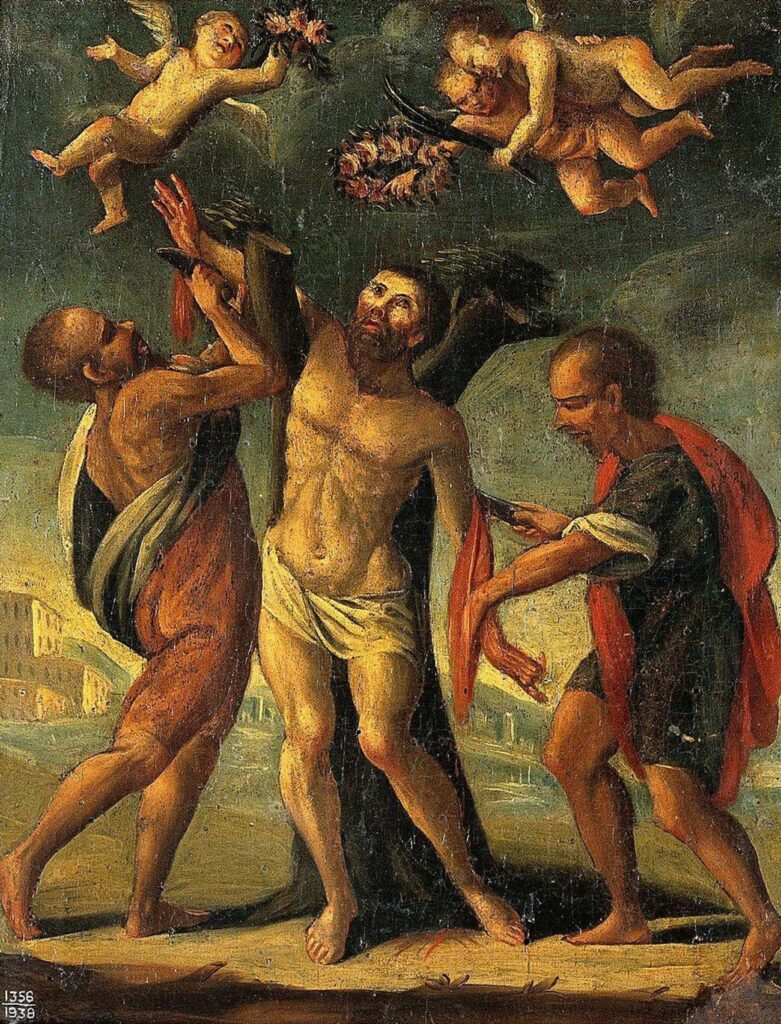
Photo: Wellcome Images / Wikimedia Commons / CC BY 4.0
Was Bartholomew flayed, crucified, or did he have his head removed? Some sources say the apostle experienced all three punishments.
Most images of Bartholomew’s martyrdom focus on the flaying, often dwelling on the moment when the saint’s skin is first pulled back from his muscle. But some include his head being removed. Another illumination from the 14th century shows the saint’s flaying on one side of the page and his head removal on the other. In the latter image, the flayed saint wears his skin around his neck like a cloak.
The French illumination ends with a prayer: “O Blessed Apostle Bartholomew, beloved of Jesus Christ, I shall praise you with full heart.”
Martyrdom Art Links Religious Self-Sacrifice To Christ’s Crucifixion

Photo: Titian / Wikimedia Commons / Public Domain
Martyrs suffer for their faith. St. Lawrence was grilled alive. St. Stephen was stoned. St. Sebastian was filled with arrows and then clubbed. Perpetua was mauled by wild animals.
The sacrifice of Christian martyrs links them to Christ, who demonstrated his religious faith by accepting suffering. Jesus was the first Christian martyr. And by suffering and persihing for their faith, later martyrs, including Bartholomew, sacrificed themselves like Christ.
Michelangelo Put His Own Face On Bartholomew’s Flayed Skin In The Last Judgment

Photo: Michelangelo / Wikimedia Commons / Public Domain
In The Last Judgment, Michelangelo hid a surprising face. The artist painted St. Bartholomew, recognizable because of the knife in his right hand and the flayed skin in his left. But it wasn’t until 1925 that a doctor spotted Michelangelo’s secret. On the flayed face of the saint, Michelangelo created a self-portrait.
Why would the artist paint himself as an empty skin? Some interpret it as a tragic metaphor for Michelangelo’s soul. Whatever Michelangelo’s motives, he may have painted the flayed skin from life. After all, the artist was a master of dissection.
Martyrdom Is A Frequent Subject Of Art Because It Is A Saint’s ‘Badge Of Honor’

Photo: Jusepe de Ribera / Wikimedia Commons / Public Domain
From one perspective, it almost seems wrong to depict St. Bartholomew with his skin tossed casually over his shoulder. Similarly, showing the martyred St. Lawrence holding a grill to symbolize his end, literally roasted over a fire, could be interpreted as bringing up a sensitive subject.
But for the Christian martyrs, their demise was a badge of honor. By suffering horrific punishments for their faith, the martyrs demonstrated their deep commitment to Christianity. By holding his skin, St. Bartholomew proclaims that he gladly perished for his faith. Wearing the badge of martyrdom proudly also linked martyrs to Jesus, the first Christian martyr.
Bartholomew Holds A Flaying Knife In Many Artistic Representations
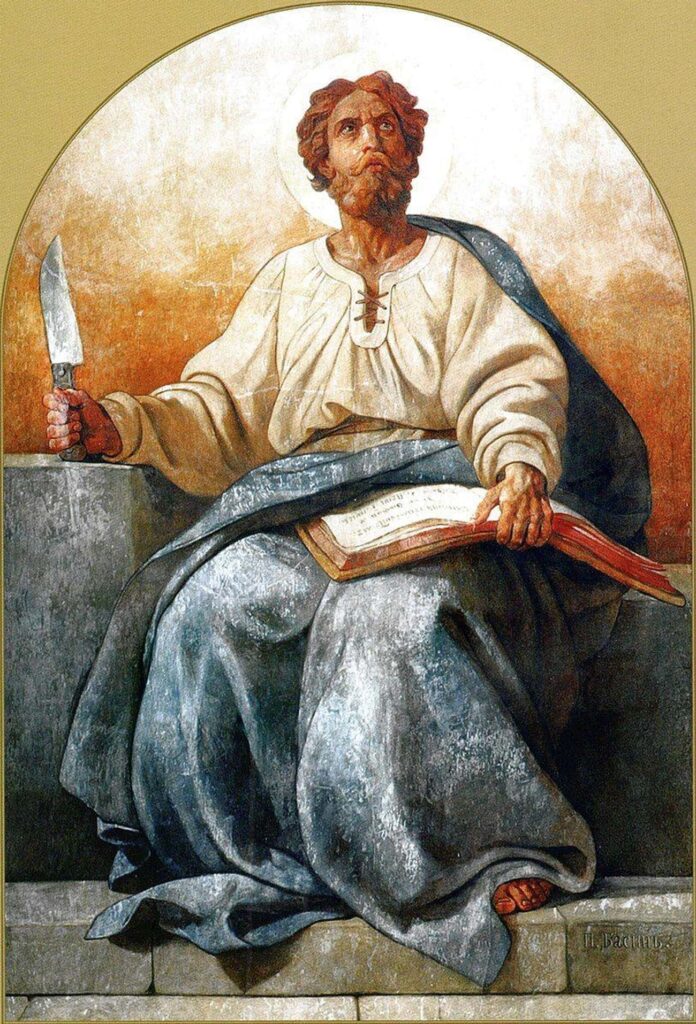
Photo: Pyotr Basin / Wikimedia Commons / Public Domain
Many depictions of Bartholomew do not show his gruesome end or portray his skinless body. Instead, the iconography of St. Bartholomew often includes more subtle references to the apostle’s fate.
In Pyotr Basin’s mural of Bartholomew, on display in St. Petersburg, Basin nods to Bartholomew’s fate by including a flaying knife in the saint’s hand. Basin also includes a book, a reference to Bartholomew’s status as one of Christ’s apostles, traveling the world to spread his faith.
The Statue Captures 16th Century Anatomical Knowledge

Photo: Cemg / Wikimedia Commons / CC BY 3.0
Sculptor Marco d’Agrate created the flayed saint who still stands in Milan’s Duomo. In 1562, when d’Agrate made the statue, artists and scholars in Italy devoted themselves to the study of the human form.
Leonardo da Vinci and Michelangelo undertook anatomical dissections to learn about the body. Just years before the Bartholomew statue appeared outside the Duomo in Milan, Andrea Vesalius published his scientific work on anatomy, detailing the muscles and sinews beneath the skin.
In that context, the Bartholomew statue represents 16th-century anatomical knowledge, demonstrating an artist’s ability to realistically capture a skinned man’s appearance.
Some Images Show Bartholomew Preaching After Losing His Skin
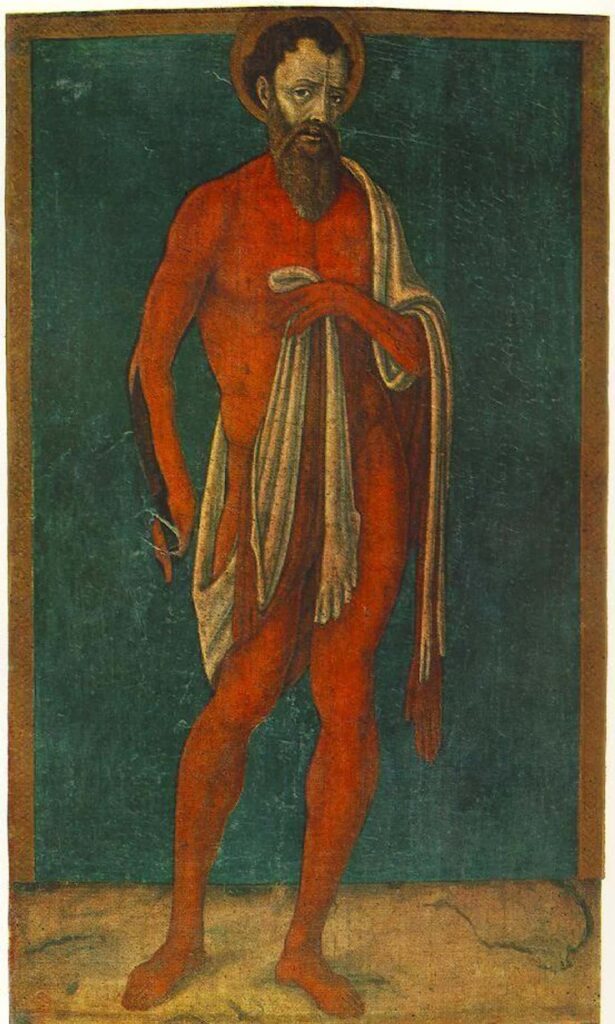
Photo: Matteo di Giovanni / Wikimedia Commons / Public Domain
Being completely flayed alive would certainly end a life. But some images captured a miraculous moment in the story of St. Bartholomew. According to several sources, Bartholomew tossed his skin over his shoulder and began preaching after his executors finished flaying him.
As an 18th-century text claimed: “When [Bartholomew] was stripped of his skin, he still remained alive, and after flaying, preached of the Lord, and only seeing the miracle, many converted.”
In Rembrandt’s Painting Of Bartholomew, The Saint Is Un-Flayed But Holds A Knife
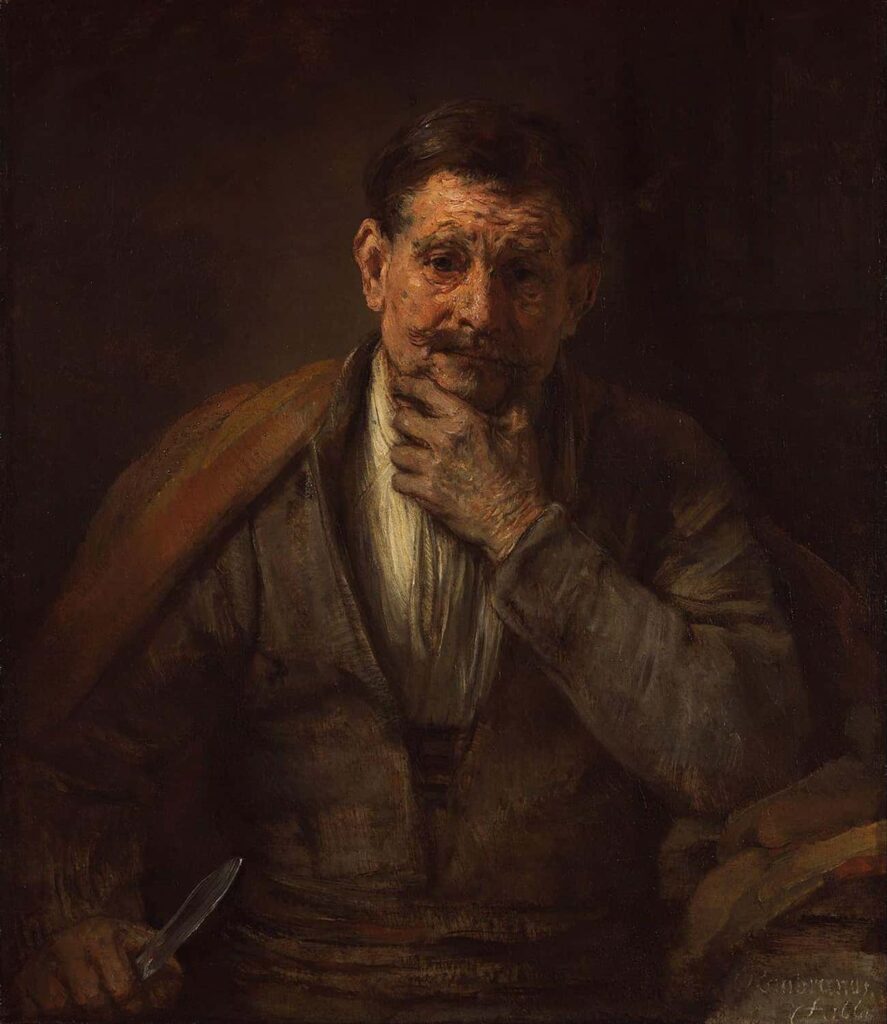
Photo: Rembrandt / Wikimedia Commons / Public Domain
Rembrandt painted an almost unrecognizable depiction of Bartholomew in 1661. Recognizable only because of the knife clutched in his hand, Rembrandt’s portrait shows the martyr as an ordinary man. Rather than highlighting Bartholomew’s gruesome end, Rembrandt emphasizes the apostle’s humanity.
The artist may have used one of his own Amsterdam neighbors as a model for the apostle. Rembrandt’s choice to paint Bartholomew as a common man demonstrates the changing religious atmosphere of the 17th century. Instead of painting the suffering martyr, Rembrandt created a melancholy, thoughtful version of the saint.
The Executioners’ Attitudes Warn About The Dangers Of Complacency

Photo: Wellcome Images / Wikimedia Commons / CC BY 4.0
Images of Bartholomew’s martyrdom rarely show the saint alone. Instead, he’s typically surrounded by two executioners. In many images, the executioners go about their business with little regard for the man’s suffering.
One painting of the martyrdom, in Burgos Cathedral in Spain, shows an executioner casually leaning back on one foot while stripping a man’s skin off his arm. Wearing a headband but not breaking a sweat, the executioner serves as a warning against complacency. The flayer might think he’s just doing his job, but the image captures the danger of complacency.
St. John The Baptist’s Head Removal Is Also A Staple Of ‘Martyrdom Art’
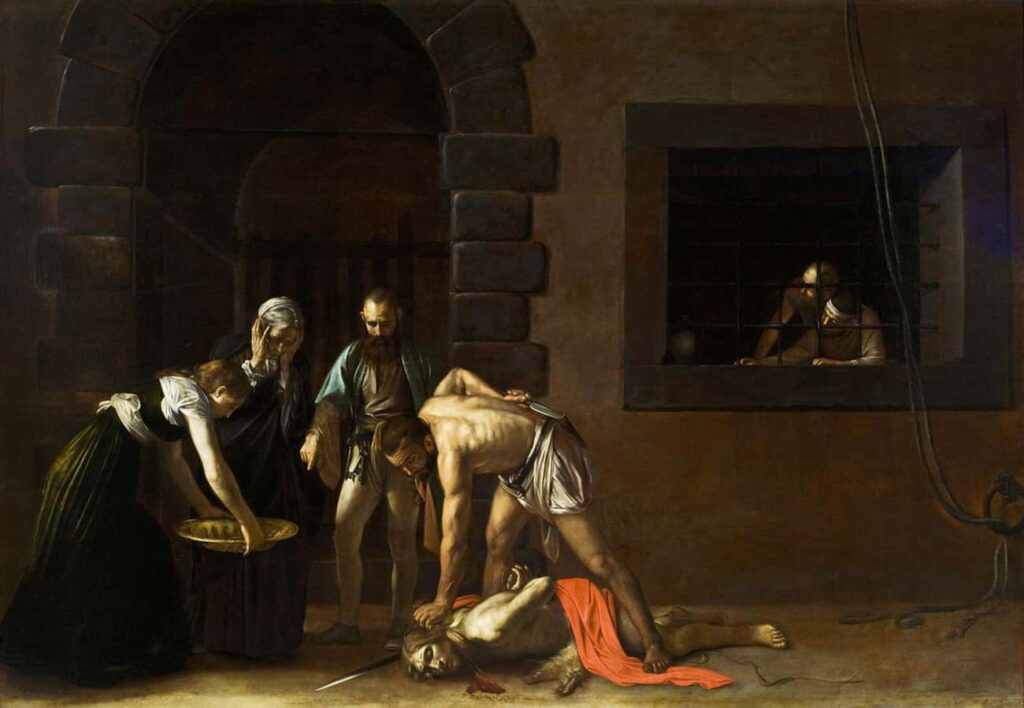
Photo: Caravaggio / Wikimedia Commons / Public Domain
Bartholomew wasn’t the only Christian martyr, of course. In fact, Christian martyrs make up an entire genre of art. For example, many artists depicted the demise of St. John the Baptist, who had his head removed.
Caravaggio chooses to show the moment in his painting of John’s end. Others present the saint’s head on a silver platter.
Artists also depicted the moment St. John escaped martyrdom. According to a story in the Golden Legend, Emperor Domitian threw St. John into a vat of boiling oil. But the saint remained unharmed by the oil, presumably thanks to God’s favor.

